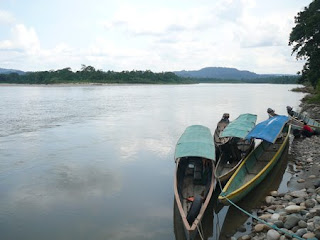Doing the "Monkey Walk"
After a work-induced hiatus that has kept me from posting on my blog for a couple of months, I cleared my calendar this weekend and took a 5-hour bus ride into the jungle to visit my friend Kelly, a Peace Corps Volunteer who has the most remote station in the province and is ending her service in a couple of weeks. She invited me to join her and a local family she knows on a “monkey walk,” her last jungle adventure before she leaves.
We crossed the river in a canoe with Kelly’s friend Yolanda and hiked half an hour to the farm of Alirio and Edith.

After a breakfast of fresh chifles (fried plaintains), coffee, and bread, we departed for the hike with Alirio guiding, Kelly and I following, and Edith, Yolanda, and Nelly taking up the rear. (Kelly and I were impressed that the women joined us, since usually on these kinds of expeditions the women are either expected to or want to stay home and cook.) In between ran two of the most energetic eight-year-olds I’ve ever met. They scampered up and down the line and were the first to charge through the foliage after Alirio cleared the trail with his machete.

I use “trail” here as a euphemism, as you can see in the photos. We were miles from anything resembling a marked trail or ranger station. Most of the four hours involved slogging, climbing, grabbing vines (watching out for thorns, spiders, and slugs), tromping, slipping and sliding (though I'm proud to say I didn't wipe out once), and sweating.



Although Alirio has cleared some of his land to plant corn, 100-acre plot we hiked through is primary rainforest. This kind of vegetation used to dominate the province, but especially in the last 40 years as oil companies and others built road to reach the eastern part of the country, small and medium farms began eating away at the native vegetation as farmers and ranchers converted it to cropland and pasture. Alirio’s father, who owns the land, has kept a good portion of it untouched so he could use it for occasional subsistence hunting (guanta, guatusa, some brids and probably a few monkeys) and collecting seeds, which the family uses for handicrafts and home medicinal remedies.
But Alirio’s father was recently widowed, so now the whole farm is up for sale, and it remains to be seen if the virgin forest we hiked through will stay that way. Sadly, it appears that this is how most of the primary rainforest in the Tena area has disappeared, not through massive clearing by state and multinational companies to grow corn and soya, as has happened in Brazil, for example, but chunk by small chunk, so gradual that it's difficult to realize that it's happening.
The "Monkey Walk" is so named because Alirio has supposedly seen monkeys on occasion, though when we asked him if he thought we'd see any this time, he said, "What, with all this noise?" as the kids ran crashing through the foliage and our voices carried over their commotion. "Walk" is also a misnomer, since for those of us raised in cities such a tame verb conjures strolls on pavement or maybe in a groomed public park. If you live in the jungle, however, walking is simply what you do when you are upright in motion and not running.
After four hours, we arrived back at the house to eat lunch with the family and recuperate.
That afternoon, eight hours after we first crossed the river, we cleaned up to the best of our ability and headed back to "the city."





















